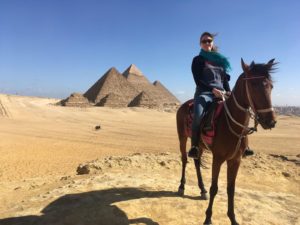In 2015 the United States (US) Department of State launched an Air Quality Monitoring Program with the primary goals of protecting US personnel and their families, obtaining sound data to reduce exposure, evaluating the Department’s enterprise risk, advancing scientific understanding, and highlighting US technology and leadership. This effort has contributed air quality reporting at many embassies and consulates around the world. Volunteer on-site Air Quality Fellows provide the scientific expertise behind this program. Air Sciences’ Dr. Katheryn Kolesar recently returned from such a trip to Cairo, Egypt.
Sited in a valley at the desert’s edge and numbering nearly 20 million residents, Cairo is the most populous city in the Middle East and has a large industrial sector. As with most mega-cities, Cairo’s streets are congested and waste management is besieged with challenges. The World Health Organization (WHO) reported that PM10 levels for the greater Cairo area were the second highest in the world among mega-cities of more than 14 million inhabitants (in the period 2011 to 2015).
On Dr. Kolesar’s brief 4-day trip, she toured the US embassy, reviewed the facility’s indoor air quality, and assessed potential sites for ambient outdoor air quality monitoring. Employee housing was also part of her review. Many apartments for Department of State employees are rented, and some historic structures boasted high ceilings and large windows. However, construction standards in Egypt focus very little on sealing a building’s envelope, filtering air, or considering air exchange rates in residences. As a result, a primary challenge for the Department of State is how to raise the housing standard for employees under these existing conditions.
 Fortunately for Dr. Kolesar, air quality in Cairo was exceptionally good during her stay. While her primary focus was volunteering her air quality expertise, she did manage to check the Great Pyramids of Giza off her bucket list — and even under a blue sky.
Fortunately for Dr. Kolesar, air quality in Cairo was exceptionally good during her stay. While her primary focus was volunteering her air quality expertise, she did manage to check the Great Pyramids of Giza off her bucket list — and even under a blue sky.

